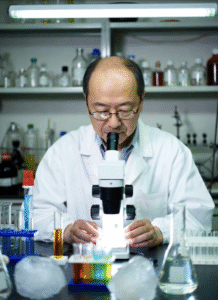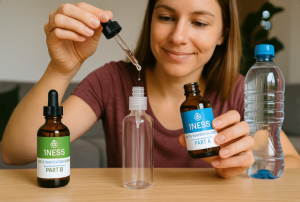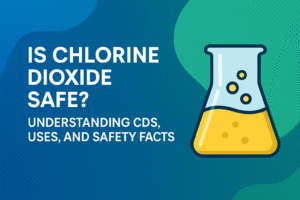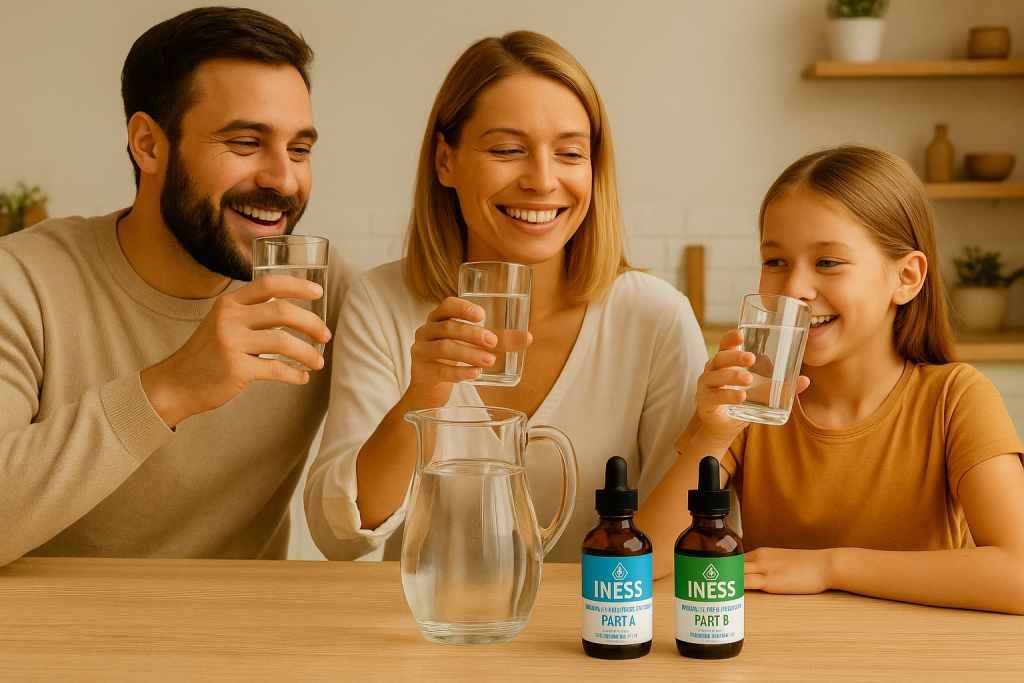Why Clean Water Is the First Step to Health
Imagine pouring a glass of water for your child. It looks clear, but is it really safe? Tap water often travels through pipes older than your grandparents. Wells can carry bacteria and protozoa. Bottled water may sit in warehouses for months. And if you’ve ever filled storage containers for emergencies, you know how quickly “fresh water” can go stale.
Every year, millions of people get sick from waterborne diseases, and many of them thought their water was safe. The truth is, access to water is easy. Access to safe water is not.
That’s why water purification is no longer a “nice-to-have.” It’s the baseline of survival and everyday wellness. And while people still boil, filter, or chlorinate, there’s a better, proven option trusted worldwide: chlorine dioxide.
Today, thanks to 1NESS Water Purification Kits, the same science used by cities and emergency relief organizations is now simple enough for anyone to use at home, while traveling, or in emergencies.
Why Safe Water Isn’t Guaranteed Anymore
You turn on the tap, fill a glass, and take a sip. The water is clear. It looks fine. But here’s the uncomfortable truth: what looks clean isn’t always safe.
Most of us grow up believing that as long as water comes from a municipal system or looks crystal-clear, it’s safe to drink. Yet, millions of people fall ill each year from waterborne pathogens hiding in “safe” water. That should tell you something: contamination is often invisible.
The Hidden Risks in Everyday Water
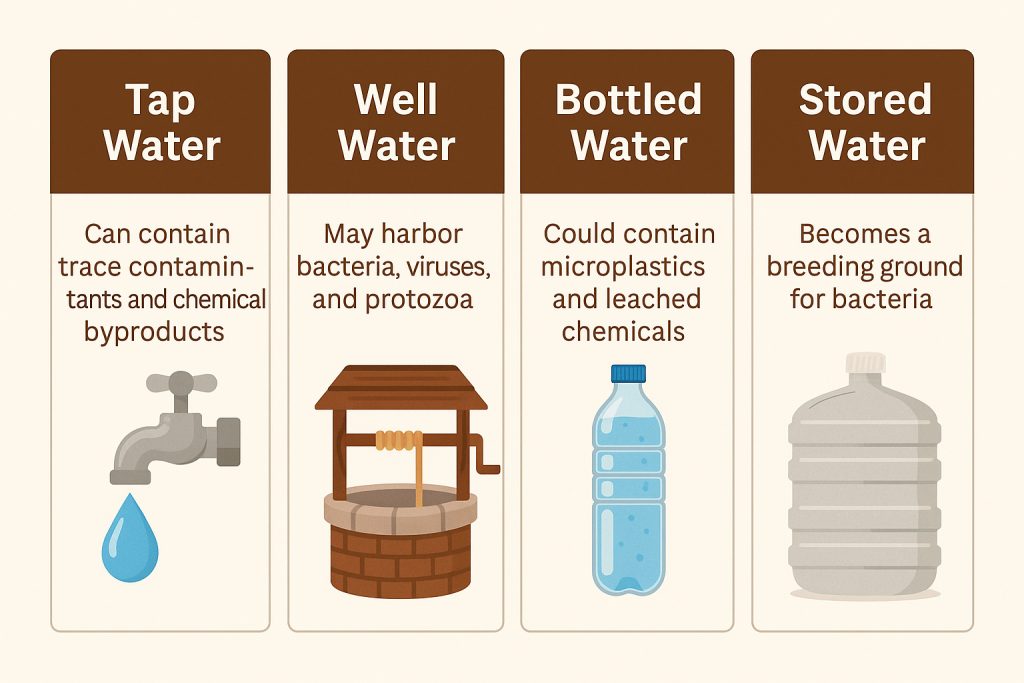
- Tap Water: Even in developed cities, tap water often contains trace contaminants. Old pipes can leach metals, and disinfectants like chlorine form chemical byproducts. The water may pass legal standards, but that doesn’t mean it’s free from health risks.
- Well Water: Private wells, used by millions worldwide, aren’t regulated like municipal supplies. They can harbor bacteria, viruses, and protozoa that cause diarrhea, stomach infections, or worse.
- Bottled Water: Many people assume bottled water is “purer,” but often it’s just repackaged tap water. Months in plastic bottles mean exposure to microplastics and leached chemicals.
- Stored Water: During emergencies, families store gallons in containers. Within weeks, that stagnant water becomes a breeding ground for bacteria.
The common thread? None of these sources can be blindly trusted.
The Global Cost of Unsafe Water
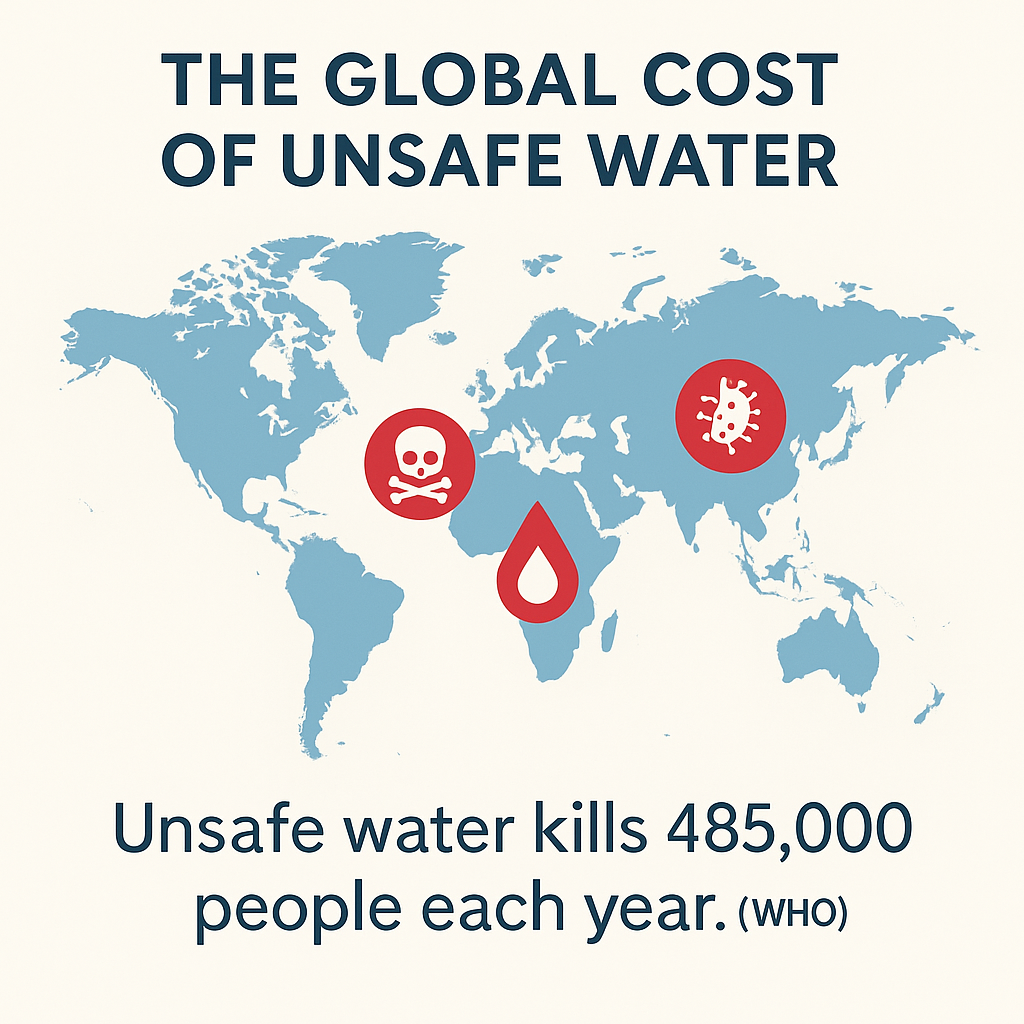
According to the WHO, unsafe drinking water contributes to over 485,000 deaths every year from diarrheal disease alone. That’s not just in rural villages, outbreaks happen even in modern cities. In Flint, Michigan, thousands were exposed to contaminated tap water. In Walkerton, Canada, E. coli in municipal water sickened an entire town.
Unsafe water isn’t an “over there” problem. It’s an everywhere problem.
Why Purification Isn’t Optional
The reality is simple: access to water is easy. Access to safe water takes intention. That’s why purification matters not just when camping or facing disasters, but every single day.
Boiling or filters might sound like enough, but they come with gaps:
- Boiling kills microbes, but doesn’t address chemical residues.
- Filters remove particles, but many don’t stop viruses.
- Chlorine (bleach) leaves taste and toxic byproducts.
What’s needed is a method that works across scenarios, at home, on the road, in the wild, or during emergencies. That’s where chlorine dioxide comes in.
From Aid Kits to Kitchen Counters
Chlorine dioxide isn’t new. It’s been used since the 1940s in municipal water plants. The Red Cross, WHO, and emergency responders rely on it for disaster relief. And today, with 1NESS Water Purification Kits, the same science is available for households.
Each kit is designed so that safe water isn’t complicated. A few drops, a clear set of instructions, and suddenly your family pitcher or emergency storage becomes a source of confidence, not concern.
Because the truth is, safe water isn’t guaranteed anymore, but with the right method, it can be.
Chlorine Dioxide Explained, The Science, the History, and the Comparisons
When people hear “chlorine dioxide,” their first reaction is often confusion. Some think it’s just another name for chlorine bleach. Others imagine something harsh or unsafe. The truth is the opposite: chlorine dioxide is one of the most precise and trusted methods for purifying drinking water worldwide.
Busting the Bleach Myth
Let’s clear this up right away: chlorine dioxide is not bleach.
- Chlorine bleach (Cl₂ or sodium hypochlorite) reacts aggressively with almost everything, producing toxic byproducts like trihalomethanes (THMs).
- Chlorine dioxide (ClO₂) is a selective oxidizer. That means it targets pathogens and organic contaminants without reacting unnecessarily with everything else.
The result? A treatment that kills bacteria, viruses, and protozoa, but leaves water tasting clean and safe.
How It Works in Simple Terms
When you activate chlorine dioxide (by combining Part A and Part B in a 1NESS Kit), a gas forms that dissolves into water. Once inside, it goes to work:
- Bacteria: Breaks through cell walls and destroys them.
- Viruses: Oxidizes the protective protein coat, rendering them harmless.
- Protozoa: Penetrates cysts like Giardia and Cryptosporidium, organisms that filters and iodine tablets often miss.
- Residues: Neutralizes pesticides, biofilm, and other organic matter.
Unlike bleach or chlorine tablets, it doesn’t leave behind harmful chemical leftovers. Once the job is done, it breaks down into harmless salts and oxygen.
A History That Inspires Confidence
Chlorine dioxide isn’t experimental. It’s been around for decades.
- 1940s: First used in municipal water treatment in the United States.
- 1970s: Became widely adopted across Europe for safe drinking water.
- Today: Over 900 water treatment facilities in the U.S. rely on it.
The World Health Organization (WHO) lists chlorine dioxide as a recommended disinfectant for safe drinking water. The EPA regulates its use in U.S. systems. The Red Cross and UNICEF distribute chlorine dioxide kits in disaster relief.
If entire cities and international aid agencies trust chlorine dioxide, it’s not a question of “if it works.” It’s simply about making it practical for households. That’s exactly what 1NESS Kits were built for.
How It Stacks Up Against Other Methods
Let’s compare chlorine dioxide with the usual suspects:
Boiling
- ✅ Kills microbes.
- ❌ Requires fuel and time, doesn’t help with chemical residues, impractical for large storage.
Bleach
- ✅ Cheap, kills bacteria and viruses.
- ❌ Bad taste, harmful byproducts, doesn’t neutralize protozoa.
Iodine Tablets
- ✅ Portable and lightweight.
- ❌ Metallic taste, unsafe for long-term use, ineffective on protozoa.
Filters
- ✅ Remove sediments, some microbes.
- ❌ Often fail against viruses, clog quickly, bulky to carry.
Chlorine Dioxide (with 1NESS Kits)
- ✅ Neutralizes bacteria, viruses, protozoa, and organic residues.
- ✅ Leaves clean taste.
- ✅ Portable, scalable (from 1 liter bottles to 50-gallon tanks).
- ✅ Breaks down safely into oxygen and salt.
When you compare, the choice is obvious.
From Cities to Homes
For decades, chlorine dioxide was something only municipalities, labs, or aid agencies could manage. It required chemicals, equipment, and training.
That’s where 1NESS comes in. Each kit contains:
- Part A and Part B in protective amber glass bottles.
- Measured droppers so you never have to guess.
- Clear instructions for safe, foolproof use.
It’s professional-grade purification, but made simple for families, travelers, and anyone who wants confidence in their water.
How to Purify Water Step-by-Step with 1NESS Kits
Clean water doesn’t have to be complicated. With chlorine dioxide, you can transform questionable water into safe drinking water in just a few minutes. And with 1NESS Water Purification Kits, the process is simple enough for anyone, no special equipment, no guesswork.
Here’s how it works in practice.
Everyday Drinking Water: 1 Liter Pitcher
Most families today use water filters or buy bottled water. Both options come with cost, plastic waste, and uncertainty. With 1NESS Kits, purifying your daily drinking water is fast and precise.
- In a dry glass, combine 2 drops of Part A + 2 drops of Part B.
- Wait 30 seconds until the solution turns a light amber color.
- Pour the solution into 1 liter (32 oz) of clean water.
- Wait 1 minute (or 15 minutes if the water looks suspicious).
Result? Fresh, safe drinking water that’s free of harmful microbes, without the chlorine taste or chemical residues.
Parents especially love this step. Instead of relying on bottled water for their kids, they know their pitcher at home is safe.
Family-Size Pitcher: 1 Gallon
If you’re preparing water for a family meal, a workout, or daily use, the process is just as simple, just scaled up.
- Mix 5 drops Part A + 5 drops Part B in a dry glass.
- Wait 30 seconds.
- Add 1 gallon of water.
- Wait 2 minutes before drinking.
This method is perfect for kitchen jugs, office coolers, or any shared supply.
Travel and Hotel Taps
Travel is one of the riskiest times for water. You never know what’s flowing through hotel taps or local wells. Many seasoned travelers carry 1NESS Kits for exactly this reason.
The method is identical:
- 2+2 drops for 1 liter,
- wait 1–15 minutes depending on clarity.
That’s all it takes to turn risky water into confidence.
Camping and Outdoor Adventures
Filters break. Fuel runs out. But a few small glass bottles of 1NESS Drops weigh next to nothing, and they deliver something no trip should be without: safe hydration.
When drinking from streams, rivers, or questionable taps:
- Pre-filter cloudy water through a cloth or bandana.
- Add the standard 2+2 drops for 1 liter or 5+5 for 1 gallon.
- Wait 30 minutes to allow full disinfection.
Hikers and backpackers often share how this process has saved them from stomach bugs and kept their trips enjoyable.
Emergency Storage and Preparedness
Nothing tests water safety like an emergency. Whether it’s a power outage, storm, or long-term storage, standing water becomes unsafe surprisingly quickly.
For stored gallons or barrels:
- Use the 5+5 drop per gallon method.
- Let treated water sit before use.
- For water stored longer than 3 months, retreat before drinking.
This is where 1NESS Kits shine for preparedness-minded households. Instead of wondering if storage is still safe, you know it is.
Why 1NESS Kits Make It Foolproof
You could technically try to source chemicals, measure doses, and study manuals. But who has time for that when your family is thirsty, or when you’re standing by a muddy stream?
1NESS Kits simplify it into a process that just works:
- Amber glass bottles protect potency.
- Measured droppers ensure accuracy.
- Printed instructions mean anyone, spouse, child, or neighbor, can use it safely.
From the first liter to the fiftieth gallon, safe water is only a few drops away.
The Human Side of Water Safety
Water isn’t just hydration. It’s peace of mind.
- A parent filling their child’s school bottle knows it’s safe.
- A traveler in a foreign country can drink confidently.
- A camper can relax, knowing their adventure won’t end in illness.
- A family storing water for emergencies doesn’t worry if it’s “gone bad.”
That’s what real safety looks like. And that’s what chlorine dioxide, and 1NESS Kits deliver every single day.
Proof, Trust, and Answers to Your Questions
When it comes to something as vital as drinking water, trust matters. You don’t just want a quick fix, you want proof that the method is safe, reliable, and globally recognized. That’s why chlorine dioxide isn’t just another “alternative.” It’s the backbone of water purification for cities, aid groups, and households alike.
Who Already Trusts Chlorine Dioxide?
- Municipal Water Systems: Over 900 U.S. cities use chlorine dioxide to keep public water safe. If it’s trusted to serve millions daily, it’s more than strong enough for your kitchen.
- World Health Organization (WHO): Lists chlorine dioxide as a safe and effective disinfectant for drinking water.
- EPA: Regulates chlorine dioxide for use in U.S. water treatment plants, with strict safety standards.
- Relief Organizations: The Red Cross and UNICEF deploy chlorine dioxide in disaster relief kits to ensure clean water when infrastructure collapses.
If it’s relied on in emergencies, disasters, and daily city life, you can feel confident using the same approach in your home.
Why People Prefer 1NESS Kits
Trust in chlorine dioxide is one thing, but why choose 1NESS Kits over generic drops or DIY solutions?
- Quality Packaging: Amber glass bottles protect ingredients from light and heat, keeping them potent longer.
- Precision Droppers: No guessing, no risk of overdosing. Just exact, repeatable measurements every time.
- Simplicity: Printed instructions walk you through step-by-step. No chemistry degree required.
- Versatility: From a 1-liter travel bottle to a 50-gallon storage tank, the same kit scales up with you.
That’s the difference between “chemicals in bottles” and a thoughtfully designed purification system.
Common Questions Answered
Is chlorine dioxide safe to drink every day?
Yes, when properly diluted. It eliminates harmful microbes but breaks down into salt and oxygen, leaving nothing unsafe behind.
Does it change the taste of water?
No. Unlike bleach or iodine, chlorine dioxide leaves water tasting clean and neutral.
How long does it take to work?
For clear water, just 1–2 minutes. For cloudy or dirty water, allow up to 30 minutes.
Can it replace a filter?
Chlorine dioxide kills pathogens but doesn’t remove heavy metals or sediment. If water looks dirty, pre-filter through a cloth before treating.
How long does treated water stay safe?
If stored in clean, sealed containers, treated water remains safe for days to weeks. For long-term storage, re-treat every few months.
How long will one 1NESS Kit last?
Each kit purifies hundreds of liters. For a family, one kit can provide months of daily protection.
Can I use 1NESS Kits for large emergency barrels?
Yes, simply scale up the dosing. That’s why the kits include measured droppers: so small or large batches are equally precise.
Final Takeaway: Water Without Worry
Water is life. But unless it’s safe, water can also be one of the fastest ways to get sick. You don’t have to leave it to chance.
Chlorine dioxide is trusted by cities, endorsed by health organizations, and proven in disaster zones. With 1NESS Water Purification Kits, that same trusted science is simplified into a few drops you can carry anywhere, from your kitchen counter to a campsite to emergency storage.
It’s not just about drinking water. It’s about peace of mind.
Explore the 1NESS Water Purification Kits today, and make every sip safe.


